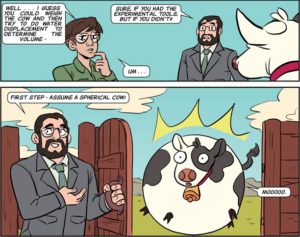Science: It Works
News came in from the Bethesda Marriott on Saturday night that all and sundry were having a great time at SPX’s Ignatz Awards ceremony¹, and the winners (list from the always valuable Johanna Draper Carlson, as it was her livetweets I saw first) include Kate Beaton (Outstanding Anthology Or Collection for Step Aside, Pops), Meredith Gran (Outstanding Online Comic for Octopus Pie), and Lisa Hanawalt (Outstanding Graphic Novel for Hot Dog Taste Test), all members of the since-disbanded-by-rent-pressures Pizza Island studio in Brooklyn.
Also pointed out Carlson, the nine awards were spread out across eight creators (only Tillie Walden repeated) and only two were won by dudes². Ladies are the future of comics, y’all — it’s scientific.
Speaking of scientific, there are two stellar examples of comics-as-science-education to commend to you today.
- First up, The Nib continues its habit of providing as much space as is necessary to tell the story, this time so that Andy Warner can bring you a sidelight the story of the biologic revolution du jour, CRISPR. If you’re not familiar with CRISPR, there’s a nice introduction at Radiolab that you can listen to; suffice it to say that it’s as revolutionary as Polymerase Chain Reaction, and may well beat out PCR for the introduction-to-Nobel Prize land speed record³.
Amazing stuff, CRISPR, with incredible potential and incredible ethical challenges ahead — and one hell of a messy legal fight between two research labs that assert they should be given the patent in lieu of their competitor. Bad Blood is Warner’s look at the issues and the fight over the potential billions of dollars of future value. You know it’s journalism masked as comics when the caption below the last panel reads Doudna, Charpentier and Zhang [the primary researchers/litigants] all declined to comment for this piece.
- Meanwhile, Dante Shepherd, or Lucas Landherr, or whoever the Batman/Bruce Wayne of Chemical Engineering is, shared the latest comic done under education research grant to teach STEM subjects. Science Comic #7, Assumptions talks about the value of approximations in scientific/engineering inquiry, starting from a reference to one of my favorite books ever: Consider A Spherical Cow, first recommended to me by Dr Frank Acker, the man that taught me to viciously oversimplify complex waveforms because damn, it works.
Shepherr4 is joined by a co-author for the first time in Science Comics, Christopher Cogswell, who is the primary explicator in the comic. Artist Carey Pietsch did a great job, in that it was immediately apparent that the teacher character was an actual person, where the learner is a stand-in for anybody that wants to know about assumptions/approximations. The result is the most accessible and readable of the comics that have been produced so far, and sets the bar for future iterations (which, per the note at the bottom of the comic, will continue later this week).
Spam of the day:
Verizon Info — Make your home safer, smarter, and more connected
The Internet of Things is a hodge-podge of ferociously insecure crap, and Verizon is a company that, 48 weeks on, still has not resolved the problem with DSL, although they finally have finally fixed the enormous static they managed to introduce into my landline. I don’t trust them to control the elements of my house any further than I could fling the members of Verizon’s executive board for distance from the height of a cliff.
BONUS PROBLEM
Consider a cliff of 100 m height, with a cylindrical Verizon board member of radius 0.25 m, length 1.7 m, and a mass of 75 kg. Gary is able to loft the board member upwards at a 12° angle above the horizontal plane at an initial velocity of 2.5 m/sec.
Neglecting tumbling effects and air resistance, how far can Gary trust Verizon to control the elements of his house? At what velocity will the Verizon board member crater into the damp sand at the base of the cliff?
_______________
¹ Sadly, I couldn’t be at any part of SPX, but I do get to see Raina Telgemeier’s Ghosts book tour tonight, so I’m going to call it even.
² I expect to see panel discussions at every con next year asking promising male creators what it’s like to create comics while male.
³ Truly huge scientific breakthroughs often take decades to show their effect, with a corresponding lag in time from publication/demonstration to the fancy award ceremony with the King of Sweden. PCR was developed in 1983 and its developer, Kary Mullis, was awarded the Nobel a scant ten years later.
4 It’s not everybody that gets their own celeb couple/shipping name all to themselves.

The above comments are owned by whoever posted them. The staff of Fleen are not responsible for them in any way.